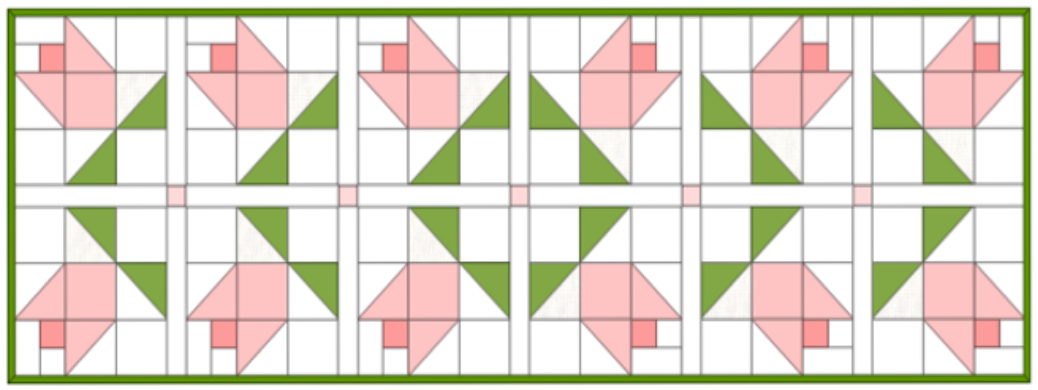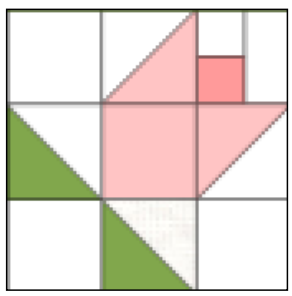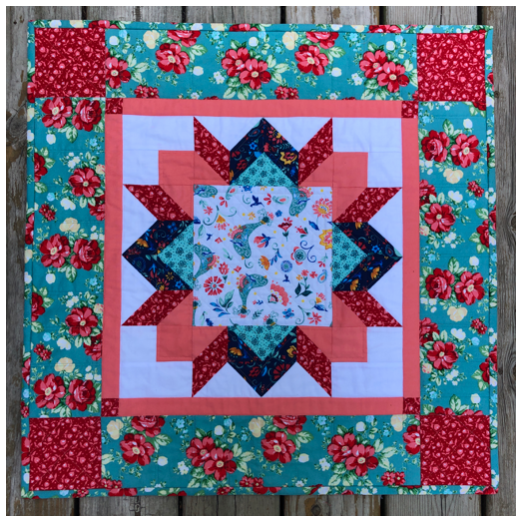Quilt inspirations come from many sources. We see a quilt block, a mosaic tile floor, or a photo and are driven to create a project. But how do we determine quilt size when it isn’t provided? Let’s examine the process and how to calculate the numbers that can assist us in figuring out the finished size of a quilt project.
There are different starting points. In some projects, a printed pattern for instance, we can extract the numbers easily. These formulas will be our vehicle for calculating the numbers we need.
Block size X number of blocks in length =
+
Sashing width X number of sashings =
+
Border width X 2=
+
Binding width X 2=
____________________________________________________
Length of the project =
Block size X number of blocks in width =
+
Sashing width X number of sashings =
+
Border width X 2=
+
Binding width X 2=
____________________________________________________
Width of the project =
Let’s do the math together. I'll use Tulip Tango as our first example.

- Our first task is to determine the size of the blocks. The pattern lists the cutting for the various pieces that make up the block. This is the clue I need to find the finished size of the blocks. There are a variety of pieces—some are half square triangles and others are a combination of squares and rectangles. In this case, we also have simple squares of white and pink. Those are cut 2-1/2”, which means that once they are stitched into the block they finish 2”. That’s the basic information I need since the block is a basic 9-patch construction, made up of three units across and three units down.
- This means 2” X 3 units = 6” blocks X 6 blocks = 36”

Block size X number of blocks in length = 36”
+
Sashing width X number of sashings =
+
Border width X 2=
+
Binding width X 2=
____________________________________________________
Length of the project =
- Let’s address the sashing next. The sashing strips are cut 1-1/2” which means once the seam allowances are subtracted, they are 1” within the project. In this example the project has five sashings the length of the runner.
- Therefore, 1” x 5 sashing units = 5”

1/2” 6” 1” 6” 1” 6” 1” 6” 1” 6” 1” 6” 1/2”
Block size X number of blocks in length = 36”
+
Sashing width X number of sashings = 5”
+
Border width X 2=
+
Binding width X 2=
____________________________________________________
Length of the project =
- This project has no borders, but if there were, determine the width of the border strips and subtract the 1/2” (combined) for seam allowances. You would then plug that width into the formula multiplied by two (since you usually have borders on both ends of the quilt.
- Border width in inches X 2 = _______________ (zero in this example)
- Binding width is part of the overall size of a project. Don’t forget the include this in the finished size of a quilt. In the majority of projects, 1/4" seam allowance is the normal width left along the outer edge of your quilt.
- Binding width in inches X 2 = 1/2"
Block size X number of blocks in length = 36”
+
Sashing width X number of sashings = 5”
+
Border width X 2 = 0
+
Binding width X 2 = 1/2"
____________________________________________________
Length of the project = 41-1/2"
Then we repeat this process for the width of a project.
Block size X number of blocks in width = 12”+
Sashing width X number of sashings = 1”
+
Border width X 2 = 0
+
Binding width X 2 = 1/2"
____________________________________________________
Width of the project = 13-1/2"
We now have the final size of our project = 13-1/2” X 41-1/2”.
Let’s run through one more example.

Garden Glory is a one-block table topper. Again, the information comes from the cutting instructions as we determine the different sections of the block.
The center square is 8-1/2”, which means it is 8” finished. To the right and left of the center, we find half square triangles that are 2-1/2” each and finish at 2” each.
There are four squares at 2” giving us an additional 8”. Our center block totals 16”.
This example contains no sashing.
Borders are next. Inner border and outer borders need to be calculated.
The inner borders are cut 1-1/2” and they will finish at 1”.
The outer borders are cut 4-1/2” and they will finish at 4”.
Add the borders together for a total of 5”.
Block size X number of blocks in length = 16”+
Sashing width X number of sashings = 0
+
Border width X 2 = 10”
+
Binding width X 2 = 1/2"
____________________________________________________
Length of the project = 26-1/2"
You now have the skills for calculating the finished size of any quilt project. Always remember to include each unit within the project in both length and width. Do keep in mind that once a quilt is layered, quilted, and laundered the size will vary slightly.
Happy calculating!

It irritates me that the designer doesn't include the size of the project generally in magazines. Now I can figure it out. Thanks. Pat
It would be great if you would make these articles printable!